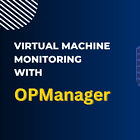Network configuration management is crucial for an adequate and healthy IT infrastructure. Organisations may control the configuration of their network devices and guarantee that their networks are operating at their peak performance, only by putting the proper procedures and tools in place.
In order to maintain a network in a consistent and desired condition, network configuration management involves gathering, monitoring, troubleshooting, and storing information about each component that makes up a network. The fundamental goal of such a system is to be ready for everything that could happen, i.e., requirement for an update, an upgrade, a recovery, or even catastrophe management. The solution will put all necessary data in the hands of the IT operations team, allowing them to choose the next course of action.
Let’s understand these crucial features in a Configuration Management solution.
1- Utilise RBAC (Role-based Access Control) to Detect Authorised & Unauthorised Access
Change in configuration and unauthorised access are undesirable from a network management perspective. Controlling who has access to devices, what modifications may be performed, and checking for the accuracy of those changes becomes crucial. By ensuring that everyone who has access to the network will only use it for tasks related to their area of expertise or jurisdiction, access control significantly lowers the likelihood that the system will experience errors.
- Consider the extensive and intricate network of a global corporation. An IT administrator would want to use these best practices to guarantee seamless operation and integrity protection:
- Assign devices within each IT operator’s scope of knowledge to prevent any mistakes or illegal access.
- Access to crucial equipment should only be granted to a few individuals so that exclusivity and integrity are always upheld.
- Ensure not overlook any change request and that it goes through a review gateway, so the admin can decide whether to approve or reject the configuration modification
- Apply best practices, such as RBAC, to maintain the network’s security.
2- Fix Firmware Vulnerabilities Through Scanning, Detection, and Patching
Firmware protects every device in the network against external risks such as data breaches and hacking attempts. Not only does the firmware conduct vulnerability checks to shield the gadget from attacks, but it also constantly upgrades to stay ahead of new potential vulnerabilities.
Let’s examine how the firmware vulnerability check technique makes it easier for an IT team to understand:
- All devices in the networking environment will have their firmware checked for vulnerabilities using a firmware vulnerability check with the most recent upgrades.
- Identify any vulnerability and develop a patch to address it.
- Software vulnerability changes with time. As security researchers discover more vulnerabilities, the process becomes perpetual. Periodic reviews guarantee that each vulnerability check is correct by keeping track of the most recent changes in the region.
Such a feature ensures that the system is impenetrable, and the network is secure.
3- Utilise Configlets to Streamline IT Admin Tasks
Implementing updates and new modifications to the network becomes a crucial duty during network administration. A slight adjustment to a device may appear easy to implement but dealing with an extensive network with several devices can be a tedious task.
Use Configlets, which are command script templates, to create a template that instructs the network configuration management solution to make a specific modification to multiple devices simultaneously. You may create templates using the Configlets feature to save time, decrease the possibility of human mistakes, and ensure their network configurations are precise and consistent.
Let’s dissect it to try to comprehend it a bit better:
- Make the same modifications without logging into each device separately by creating a template with a script and deploying it to all devices simultaneously with a single click.
- Such jobs are repeated and cyclical. An IT staff may therefore save a significant amount of man-hours that could be employed elsewhere by adopting command script templates.
- Generate reports showing configuration trends and changes made up to this point, analyze the patterns and use them to guide future change decisions.
4- Automated Log & Tracking of Every Change
Because each mistake might result in an incident that affects more people, network administration is a delicate and crucial task. Maintaining a tight leash and keeping a watch on the “who, what, and when” of the network are essential to minimise configuration update problems.
An IT operations staff managing a sizable network will get overworked if they must manually keep track of every modification that is made. However, logging is still essential because:
- They serve as a record of any modifications performed, assisting the team in reviewing and connecting them to outages should they occur.
- An administrator or operator would want to get warnings immediately when an action that might be worrisome occurs.
- Examining the logs and compare configurations to determine the root cause of an outage, in case of occurrence.
Implement change management to record every change made to the network correctly, and immediately alert on modifications deemed critical by reviewing outages and making decisions to prevent future errors
Overall automatic log tracking is a valuable technique for efficient network configuration management. Automated log tracking may assist companies in guaranteeing their networks’ health, performance, and security by supplying insight into network changes, ensuring compliance, and enhancing efficiency.
5- Comply with Industry and Custom-Made Standards
Industry standards serve as the barometer and ideal procedure to be followed in all aspects of the company. Because network configuration management usually assesses the compliance rating concerning industry standards and internal company requirements, compliance checks are crucial. Therefore, it is essential to emphasise the significance of network compliance audits. Every time a violation occurs, the procedure is never-ending, and if it isn’t fixed immediately, it might cost a lot of resources.
Regular compliance audits are essential because:
- Ensuring the company complies with and refrains from breaking the possible regional set of rules.
- Every organisation has laws of its own. Use compliance tests to ensure you completely comply with the internal standards in conjunction with the legal team.
- Run regular compliance checks to look for infractions so that you can get to work fixing them immediately.
With IT standards like HIPAA, SOX, and PCI, network management is no different from other industries with industry-mandated standards. Compliance checks are the fail-safe that guards the network against flaws and data breaches.
6- Make a Backup of all the Network’s Startup and Running Configurations
Businesses expect their networks to operate without interruption. On the other hand, we must also admit that network disruptions and the ensuing downtime are a fact of life. It would be advisable for the network operators to have a safety net in place in case of failure because downtime might occur at any time.
As a result, backup turns into the core of network administration, enabling you to upload the most reliable configuration file for usage in an outage. Using the network backup configuration setting in the event of a network disaster, allows business to continue as normal.
Here’s how to use a backup to protect your network against outages:
- Make sure that startup and running settings are always in sync to prevent missing configuration updates.
- Knowing that changes occur daily or on a regular basis, make sure to back them up promptly.
- From your collection of configuration settings, choose the configuration that is the most dependable and stable.
- When you upload your trusted stable configuration as a backup, it serves as the fallback system for maintaining network availability in the event of a failure.
- The IT crew won’t have to worry and go into troubleshooting overdrive if such a system is in place. We will automate the procedure to maintain network continuity.
To ensure the best possible protection for your network, it is essential to both back up your data frequently and to test those backups regularly to make sure they are functioning properly. This way, you can be confident that you can restore your network in the event of a system failure. In order to do this, you may periodically restore your network from a backup and test it to make sure everything is running well.
Why Choose Network Configuration Manager by ManageEngine for Your All-in-One Configuration Solution
When performed manually, network configuration management is a function that requires many lengthy, tedious hours and operations that are prone to mistakes. The network’s security and integrity are crucial, and having to complete menial activities will cut into the time you have available for high-priority duties. Network Configuration Manager (NCM) from ManageEngine is a comprehensive solution that aids in monitoring, analysing, and automating changes across a more extensive network for your business.
The Network Configuration Manager’s main features include the following:
- Backups of network configurations can handle unexpected disruptions.
- Discover any modifications and monitor those changes in real time via notifications on primary devices.
- Comparing alternative device setups and accessing change management data that go down to specific parameters
- Through compliance inspections, abide by industry standards as well as specific policies.
- Use firmware vulnerability checks to protect the network from potential flaws and vulnerabilities.
- Assign devices, grant access, limit modifications, and review changes before implementing to ensure security
- Automate time-consuming, repetitive chores using Configlets.
Network configuration management is a crucial aspect of maintaining the stability and security of a company’s IT infrastructure. Our services can help streamline and automate the process, resulting in increased efficiency and reduced risk of human error. We have a team of experienced professionals who are well-versed in the latest tools and techniques for network configuration management. If you’re interested in learning more about how we can help your organization, please don’t hesitate to reach out to us to schedule an appointment.

